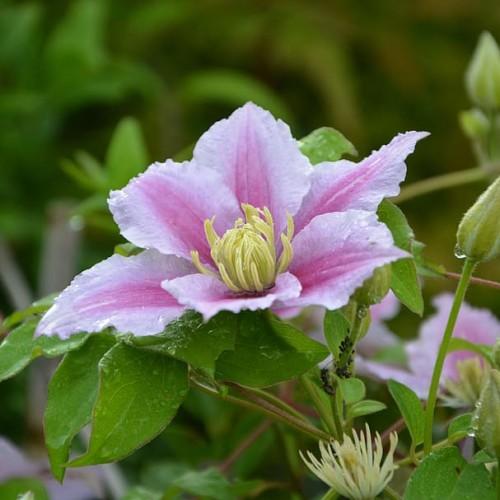
clematis
Clematis 'Andromeda'
Cycle:
Perennial
Watering:
Average
Hardiness Zone:
4 - 8
Flowers:
Flowers
Sun:
Full sun,part shade
Leaf:
Yes
Growth Rate:
High
Maintenance:
Low
Care Level:
Medium
watering
For Clematis 'Andromeda', it is best to water thoroughly and deeply once a week during the growing season. Water needs to get down to the roots, so apply water slowly and for a long time. Water in the morning to avoid mildew and other fungi growth, and water at the base of the plant to reduce leaf wetness and therefore the risk of diseases. In extremely hot weather, or if the plant shows signs of wilting, add water more frequently. In winter, water only when necessary and supply enough water that the roots do not dry out or freeze.
sunlight
Clematis 'Andromeda' is a sun-loving vine that should be given plenty of sunlight in order to reach its full potential. Ideally this plant should receive 6-8 hours of direct sunlight each day, however it can tolerate some partial shade. It should be positioned in an area where it will receive most of its sunlight before noon, given that too much intense afternoon sun can burn its sensitive foliage. This species of clematis is a heavy feeder and may need additional fertilization once it has become well-established in its environment.
pruning
The best time to prune a Clematis 'Andromeda' plant is in early spring, just after flowering ends. Prune lightly, removing only dead or diseased stems and cutting back overgrown stems to a healthy shoot. Avoid pruning beyond the healthy shoots, as this can cause damage to the bloom cycle of the plant. Do not prune more than 1 third of the growth at a time as this can also cause damage. Pruning for Clematis 'Andromeda' requires patience and precision as it is easy to damage the blooms and slow down the growth of the plant.
Season
Hardiness Map
FAQ
Can Clematis plants grow in pots?
Yes, Clematis plants can definitely be grown in pots. When planting a Clematis in a pot make sure to use a larger size pot with drainage holes and fill it with a mix of well-draining potting soil and compost. Ensure to keep the root area cool and the pot in a sunny location while providing regular water and fertilization. Check the plant almost daily to make sure it is not becoming too dry. Clematis can do well in a pot and with the right care and conditions, they will thrive.
Are Clematis plants self-pollinating?
No, clematis plants are not self-pollinating. Clematis plants need pollinators such as bees, butterflies, moths and other insects to transfer pollen from the male anthers to the female stigma of the flower in order to produce viable seed. Pollination must also occur within relatively close proximity of the same species in order to create viable hybrid plants.
Can Clematis plants be grown as a houseplant?
Yes, Clematis plants can be grown as a houseplant. It is best to grow them in a pot with full sun and a soil that is rich in organic material and retains moisture. When potting the plant, place a stake or trellis next to the pot so that the vine can climb when it begins to grow. Be sure to water your Clematis plant regularly to keep it healthy and growing. Additionally, keep an eye out for pests and treat with natural insecticides as necessary.
Could Clematis plants survive in a colder climate?
Yes, Clematis plants can survive in colder climates with proper preparation. If planted in the fall, proper mulching should be done to protect the roots from cold temperatures. If planted in the spring, they should be watered frequently to help them adjust to the cooler temperatures more quickly. If temperatures drop below -20°C ( -4°F), additional measures may need to be taken such as the application of protective wraps and thermal insulation. Additionally, plants in exposed areas should be protected from the wind to prevent excessive dehydration. With the right measures in place, Clematis plants can easily survive in colder climates.
Could Clematis plants be grown in a greenhouse?
Yes, clematis plants can be grown in a greenhouse. Due to their vine-like growth habit and tropical native origins, clematis plants thrive in the moist and warm environment of a greenhouse. Clematis are generally grown from cuttings or from dividing existing plants, and benefit from regular pruning and fertilizing. They will also enjoy the indirect light of a greenhouse and the protection from strong winds and temperatures that the humidity and contained environment provides.
